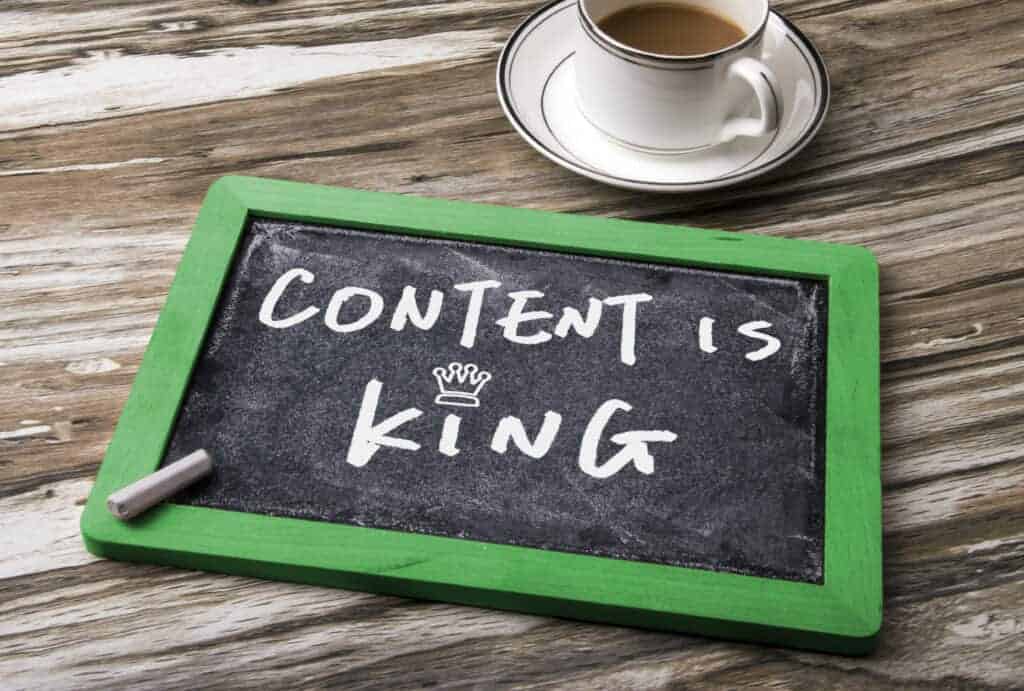eCommerce Content Marketing is the new King.
In 1996 Microsoft founder and innovation visionary Bill Gates, used this phrase in an essay he wrote describing the future of the Internet as a marketplace for content.
And here we are.
Today, more than ever it’s crucial that e-commerce businesses use various content marketing techniques to attract, engage and convert potential consumers into repeat customers in the world of online retail.
Central to the success of a website’s brand, the creation of consistent, interesting, quality and relevant content has the ability to increase foot traffic, engage an audience and ultimately increase sales.
While content marketing is already hugely popular in the e-commerce world to engage, and retain customers, it’s especially true for the B2B market.
Whether it’s a blog or article, email campaign, product descriptions, social media images and video, content is still king.
With today’s consumers even more demanding, businesses have no choice but to adapt to their audience. Below are several strategies to grow your e-commerce business with content marketing. But first, what is content marketing?
WHAT IS ECOMMERCE CONTENT MARKETING?
Ecommerce content marketing focuses on creating, publishing and circulating content for a targeted audience. It’s goal is to attract potential buyers to a product or service and make them a customer by providing free, shareable information that’s valuable to consumers.
Businesses use content marketing to manage and sustain brand loyalty, creating a desire to purchase from the company in the future. Although content marketing is focused on sales, it doesn’t involve direct sales. Instead, it builds a rapport with its audience, creating a trusting relationship.
THE RELEVANCY OF ECOMMERCE CONTENT MARKETING
How you influence your audience to make a purchase should vary depending on the market you’re targeting. Because of the various types of content, it’s important to find out what works best for your business and catches the attention of your demographic.
Depending on what you’re selling you can engage an audience using humor, a call to action or through thought-provoking content. Know your audience and cater to their personality by distributing content that’s entertaining, insightful, or informative.
Whatever ecommerce content marketing strategy you use, remember to offer quality over quantity.
ARTICLES AND BLOGS
Articles are typically used to convey information, through more in depth content to educate or inform your audience. It’s well-researched, factual information backed with quotes from relevant experts and verified statistics. This form of ecommerce content marketing typically starts at 750 words and can expand to two to four times that length depending on the topic and the depth of what you’re trying to convey.
Blogs can be relatively short (75 to 300 words), medium in length (300 to 600 words) or exceedingly more. A recent article produced by Hubspot, a developer and software product marketer, reported data that stated while the “ideal” blog post length for SEO ranking purposes is between 2,100 – 2,400 words, its individual blogs ranged from 333 to 5,581.
However, know that not all posts need to be or should be that long. In fact, Hubspot also reported that about one-third of its top 50 read posts were less than 1,500 words.
Although each category may have an ideal word range, they will vary based on the content within it. All said and done a blog post should be however long it needs to be to convey your message.
ECOMMERCE MARKETING USING EMAIL
A successful ecommerce content marketing email grabs the reader’s full attention by asking a personal or thought-provoking question, providing relevant information or offering exclusivity and unique value.
On average, email marketing has a 4400 percent ROI, according to OptinMonster. Statista says that nearly 50 percent of consumers say they would like to receive promotional emails from their favorite brands on a weekly basis.
Content should be original and creative, distributing appropriate, relevant content that’s consistent across platforms to your target audience.
When executed correctly, the content your business distributes will result in a response by the consumer to purchase your product or service.
SEO (SEARCH ENGINE OPTIMIZATION) STRATEGIES
First thing’s first. SEO and ecommerce content marketing are two different things. They actually complement and fuel each other, working with the same goal of creating a successful digital marketing campaign.
Whether you hire an SEO expert or teach yourself the ropes, the goal is to ensure your brand is visible and viewed by a specific audience.
Doing this involves what’s called SEO strategies that work to get the right eyes on a particular piece of content. These are well-thought out ways to boost sales by making content more visible in organic search engine rankings via keywords or phrases.
However, without content SEO is dead in the water. It needs content to help match specific search keywords.
ECOMERCE MARKETING SOCIAL MEDIA
Does your brand have various accounts for social media platforms? It should. Especially in today’s market, e-commerce businesses don’t have the luxury of ignoring it. Your business can see a huge boost in sales through generated traffic from social media.
In this digital climate if you aren’t putting yourself out there, you might as well not exist. That’s because 55 percent of consumers do research via social media before making a purchase, according to IBM.
From influencers on Facebook, Twitter, Instagram and TikTok, gaining a social media following isn’t an option. You simply cannot neglect your social media presence if you want to compete with your peers.
VIDEOS
Not that you’ve heard it for the first time here, but video is a dominating force in social media. From Instagram influencers to celebrities and just the average Joe, EVERYONE who is ANYONE that’s successful is using it.
For content that might be too long for a blog post, consider creating a video to use as a ecommerce marketing tool. After all, we’re in the age of instant gratification with audiences largely geared toward engaging with visual content.
What’s great is that video marketing is more cost effective than ever with the standard smartphone. Remember to keep videos simple, relatable, authentic and meaningful.
IN CONCLUSION
Whatever content you’re producing, make sure you keep it fresh and interesting. Figure out a schedule and organize it through a social media management platform such as Buffer or Hootsuite so your audience knows when to expect to receive it. Check out these social media tips for ecommerce here.
If you’re running low on ideas, try doing some general research for ways to provide fresh content. Reading the day’s news or brushing up on “this day in history” inspiration can give insight into creating new, original content or provide ways to recycle archived content to make it new again.
When executed correctly, ecommerce content marketing has the ability to catapult the success of your e-commerce business. Developing and focusing on this educated you on your business and audience simultaneously, effectively revealing the value of the craft.

